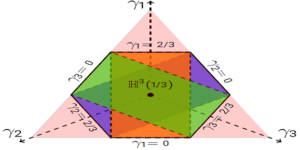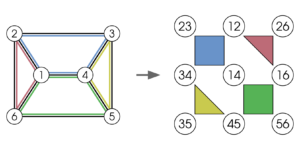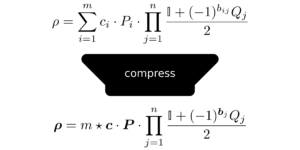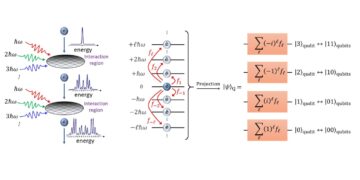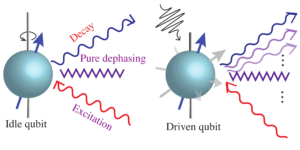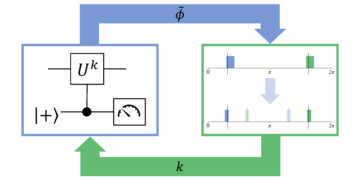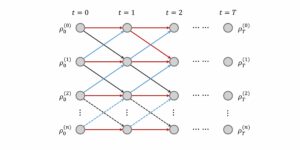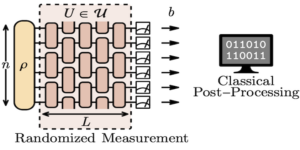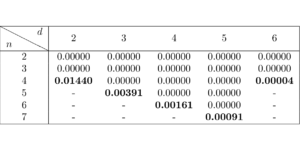1Department of Physics and Astronomy, Purdue University, West Lafayette
2Department of Mathematics, Purdue University, West Lafayette
Find this paper interesting or want to discuss? Scite or leave a comment on SciRate.
Abstract
We propose a systematic and efficient quantum circuit composed solely of Clifford gates for simulating the ground state of the surface code model. This approach yields the ground state of the toric code in $lceil 2L+2+log_{2}(d)+frac{L}{2d} rceil$ time steps, where $L$ refers to the system size and $d$ represents the maximum distance to constrain the application of the CNOT gates. Our algorithm reformulates the problem into a purely geometric one, facilitating its extension to attain the ground state of certain 3D topological phases, such as the 3D toric model in $3L+8$ steps and the X-cube fracton model in $12L+11$ steps. Furthermore, we introduce a gluing method involving measurements, enabling our technique to attain the ground state of the 2D toric code on an arbitrary planar lattice and paving the way to more intricate 3D topological phases.
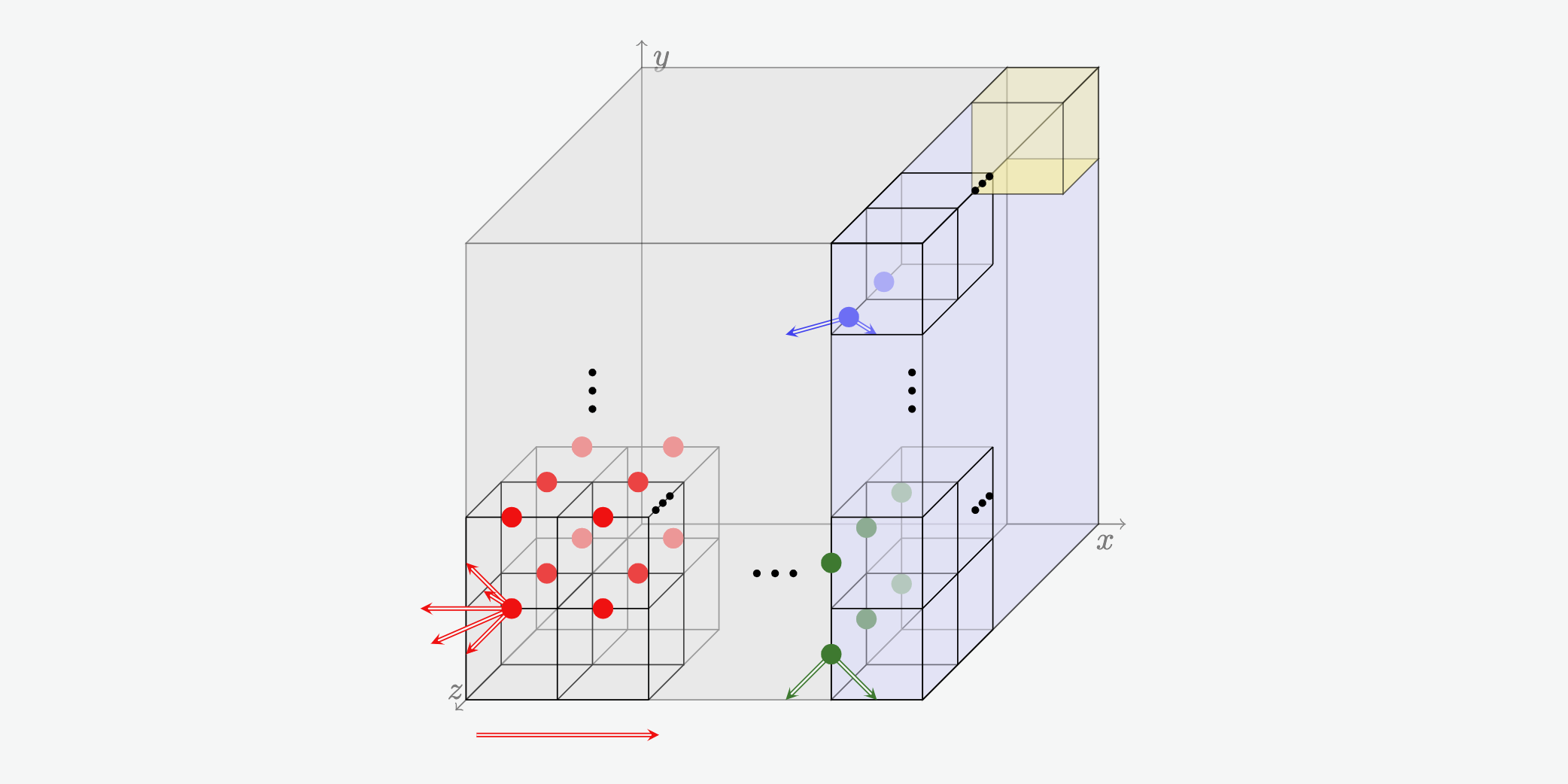
Featured image: Construction of a quantum circuit for the 3D toric model on an $L times L times L$ lattice over a 3-dimensional torus.
Popular summary
► BibTeX data
► References
[1] Miguel Aguadoand Guifre Vidal “Entanglement renormalization and topological order” Physical review letters 100, 070404 (2008).
https://doi.org/10.1103/PhysRevLett.100.070404
[2] Sergey Bravyi, Matthew B Hastings, and Spyridon Michalakis, “Topological quantum order: stability under local perturbations” Journal of mathematical physics 51, 093512 (2010).
https://doi.org/10.1063/1.3490195
[3] Sergey Bravyi, Matthew B Hastings, and Frank Verstraete, “Lieb-Robinson bounds and the generation of correlations and topological quantum order” Physical review letters 97, 050401 (2006).
https://doi.org/10.1103/PhysRevLett.97.050401
[4] Sergey Bravyi, Isaac Kim, Alexander Kliesch, and Robert Koenig, “Adaptive constant-depth circuits for manipulating non-Abelian anyons” arXiv:2205.01933 (2022).
https://doi.org/10.48550/arXiv.2205.01933
[5] Sergey B Bravyiand A Yu Kitaev “Quantum codes on a lattice with boundary” arXiv preprint quant-ph/9811052 (1998).
https://doi.org/10.48550/arXiv.quant-ph/9811052
[6] Eric Dennis, Alexei Kitaev, Andrew Landahl, and John Preskill, “Topological quantum memory” Journal of Mathematical Physics 43, 4452–4505 (2002).
https://doi.org/10.1063/1.1499754
[7] Sepehr Ebadi, Tout T Wang, Harry Levine, Alexander Keesling, Giulia Semeghini, Ahmed Omran, Dolev Bluvstein, Rhine Samajdar, Hannes Pichler, and Wen Wei Ho, “Quantum phases of matter on a 256-atom programmable quantum simulator” Nature 595, 227–232 (2021).
https://doi.org/10.1038/s41586-021-03582-4
[8] Jeongwan Haah “Local stabilizer codes in three dimensions without string logical operators” Physical Review A 83, 042330 (2011).
https://doi.org/10.1103/PhysRevA.83.042330
[9] Oscar Higgott, Matthew Wilson, James Hefford, James Dborin, Farhan Hanif, Simon Burton, and Dan E Browne, “Optimal local unitary encoding circuits for the surface code” Quantum 5, 517 (2021).
https://doi.org/10.22331/q-2021-08-05-517
[10] A Yu Kitaev “Fault-tolerant quantum computation by anyons” Annals of Physics 303, 2–30 (2003).
https://doi.org/10.1016/S0003-4916(02)00018-0
[11] Michael A Levinand Xiao-Gang Wen “String-net condensation: A physical mechanism for topological phases” Physical Review B 71, 045110 (2005).
https://doi.org/10.1103/PhysRevB.71.045110
[12] Yu-Jie Liu, Kirill Shtengel, Adam Smith, and Frank Pollmann, “Methods for simulating string-net states and anyons on a digital quantum computer” arXiv:2110.02020 (2021).
https://doi.org/10.1103/PRXQuantum.3.040315
[13] Abhinav Prem, Jeongwan Haah, and Rahul Nandkishore, “Glassy quantum dynamics in translation invariant fracton models” Physical Review B 95, 155133 (2017).
https://doi.org/10.1103/PhysRevB.95.155133
[14] KJ Satzinger, Y-J Liu, A Smith, C Knapp, M Newman, C Jones, Z Chen, C Quintana, X Mi, and A Dunsworth, “Realizing topologically ordered states on a quantum processor” Science 374, 1237–1241 (2021).
https://doi.org/10.1126/science.abi8378
[15] Kevin Slagleand Yong Baek Kim “Quantum field theory of X-cube fracton topological order and robust degeneracy from geometry” Physical Review B 96, 195139 (2017).
https://doi.org/10.1103/PhysRevB.96.195139
[16] Nathanan Tantivasadakarn, Ruben Verresen, and Ashvin Vishwanath, “The Shortest Route to Non-Abelian Topological Order on a Quantum Processor” arXiv:2209.03964 (2022).
https://doi.org/10.1103/PhysRevLett.131.060405
[17] Nathanan Tantivasadakarn, Ashvin Vishwanath, and Ruben Verresen, “A hierarchy of topological order from finite-depth unitaries, measurement and feedforward” arXiv:2209.06202 (2022).
https://doi.org/10.1103/PRXQuantum.4.020339
[18] Nathanan Tantivasadakarn, Ryan Thorngren, Ashvin Vishwanath, and Ruben Verresen, “Long-range entanglement from measuring symmetry-protected topological phases” arXiv:2112.01519 (2021).
https://doi.org/10.48550/arXiv.2112.01519
[19] Ruben Verresen, Mikhail D Lukin, and Ashvin Vishwanath, “Prediction of toric code topological order from Rydberg blockade” Physical Review X 11, 031005 (2021).
https://doi.org/10.1103/PhysRevX.11.031005
[20] Ruben Verresen, Nathanan Tantivasadakarn, and Ashvin Vishwanath, “Efficiently preparing Schrödinger’s cat, fractons and non-Abelian topological order in quantum devices” arXiv:2112.03061 (2021).
https://doi.org/10.48550/arXiv.2112.03061
[21] Sagar Vijay, Jeongwan Haah, and Liang Fu, “A new kind of topological quantum order: A dimensional hierarchy of quasiparticles built from stationary excitations” Physical Review B 92, 235136 (2015).
https://doi.org/10.1103/PhysRevB.92.235136
[22] Sagar Vijay, Jeongwan Haah, and Liang Fu, “Fracton topological order, generalized lattice gauge theory, and duality” Physical Review B 94, 235157 (2016).
https://doi.org/10.1103/PhysRevB.94.235157
[23] Kevin Walkerand Zhenghan Wang “(3+ 1)-TQFTs and topological insulators” Frontiers of Physics 7, 150–159 (2012).
https://doi.org/10.1007/s11467-011-0194-z
Cited by
[1] Xie Chen, Arpit Dua, Michael Hermele, David T. Stephen, Nathanan Tantivasadakarn, Robijn Vanhove, and Jing-Yu Zhao, “Sequential quantum circuits as maps between gapped phases”, Physical Review B 109 7, 075116 (2024).
[2] Nathanan Tantivasadakarn and Xie Chen, “String operators for Cheshire strings in topological phases”, arXiv:2307.03180, (2023).
The above citations are from SAO/NASA ADS (last updated successfully 2024-03-17 11:18:40). The list may be incomplete as not all publishers provide suitable and complete citation data.
On Crossref’s cited-by service no data on citing works was found (last attempt 2024-03-17 11:18:38).
This Paper is published in Quantum under the Creative Commons Attribution 4.0 International (CC BY 4.0) license. Copyright remains with the original copyright holders such as the authors or their institutions.
- SEO Powered Content & PR Distribution. Get Amplified Today.
- PlatoData.Network Vertical Generative Ai. Empower Yourself. Access Here.
- PlatoAiStream. Web3 Intelligence. Knowledge Amplified. Access Here.
- PlatoESG. Carbon, CleanTech, Energy, Environment, Solar, Waste Management. Access Here.
- PlatoHealth. Biotech and Clinical Trials Intelligence. Access Here.
- Source: https://quantum-journal.org/papers/q-2024-03-13-1276/
- :is
- :not
- :where
- 1
- 10
- 100
- 11
- 12
- 13
- 14
- 15%
- 16
- 17
- 19
- 1998
- 20
- 2005
- 2006
- 2008
- 2011
- 2012
- 2015
- 2016
- 2017
- 2021
- 2022
- 2023
- 2024
- 22
- 23
- 2D
- 3d
- 40
- 43
- 51
- 7
- 8
- 9
- 97
- a
- above
- ABSTRACT
- access
- Achieve
- Adam
- Additionally
- affiliations
- ahmed
- Alexander
- algorithm
- All
- an
- and
- Andrew
- Application
- approach
- arbitrary
- ARE
- arpit
- AS
- astronomy
- attain
- attempt
- author
- authors
- balances
- BE
- between
- boundary
- bounds
- Break
- built
- by
- capabilities
- CAT
- certain
- chen
- code
- codes
- comment
- Commons
- complete
- composed
- computation
- computer
- construction
- copyright
- correlations
- data
- David
- depth
- Devices
- digital
- dimensions
- discuss
- distance
- dynamics
- e
- efficient
- enabling
- encoding
- entanglement
- eric
- Even
- extension
- facilitates
- facilitating
- field
- For
- found
- Framework
- frank
- from
- Frontiers
- fu
- Furthermore
- Gates
- gauge
- General
- generalized
- generation
- Ground
- harvard
- hierarchy
- holders
- HTTPS
- image
- in
- institutions
- interesting
- International
- into
- intricate
- introduce
- involving
- ITS
- james
- JavaScript
- John
- jones
- journal
- Kim
- Kind
- Knapp
- Last
- Leave
- levine
- License
- linear
- List
- local
- logical
- Maintaining
- manipulating
- Maps
- mar
- mathematical
- mathematics
- Matter
- matthew
- max-width
- maximum
- May..
- measurement
- measurements
- measuring
- mechanism
- Memory
- method
- Michael
- mikhail
- model
- models
- Month
- more
- Nature
- New
- no
- of
- on
- ONE
- open
- operators
- or
- order
- original
- our
- over
- pages
- Paper
- Paving
- phases
- Phases of Matter
- physical
- Physics
- plato
- Plato Data Intelligence
- PlatoData
- prem
- preparing
- Problem
- Processor
- programmable
- propose
- provide
- published
- publisher
- publishers
- purely
- Quantum
- Quantum Computer
- references
- refers
- remains
- represents
- review
- ROBERT
- robust
- Route
- Ryan
- s
- Science
- shawn
- shortest
- Simon
- simulation
- simulations
- simulator
- Size
- smith
- solely
- specific
- Stability
- State
- States
- Stephen
- Steps
- String
- Successfully
- such
- suitable
- Surface
- system
- technique
- that
- The
- their
- theory
- this
- three
- time
- times
- Title
- to
- topological quantum
- Translation
- under
- university
- updated
- URL
- use
- volume
- wang
- want
- was
- Way..
- we
- West
- which
- while
- Wilson
- with
- without
- works
- X
- year
- yields
- zephyrnet
- Zhao




